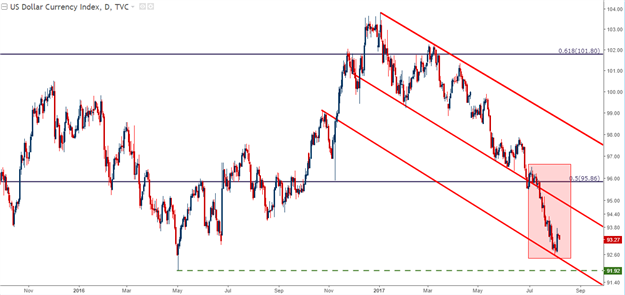In yesterday’s article, we looked at the U.S. Dollar after last week saw a gain in the Greenback for the first time since early-July. As we had shared, given the aggressive topside run posted in the Euro through the first seven months of this year, the U.S. Dollar has contracted by more than -10%. This is likely driven by a series of factors, key of which has been a slowdown in U.S. data as the Federal Reserve has appeared to shift their focus towards balance sheet reduction.
The downside move in the Dollar this year has wiped away the entirety of the post-Election move in USD, and we’re now inching closer to the 2016-low at 91.92. On the chart below, we’re looking at the bearish trend channel that’s built in the Greenback this year, along with emphasis on the hastening of the move after we entered July.
U.S. Dollar Daily via ‘DXY’: Down-Trend Hastened in July

Chart prepared by James Stanley
As we looked at yesterday, this blip of strength in the U.S. Dollar came-in around Friday’s NFP report, after a rather solid set of numbers were released for July. But given the extreme oversold nature of the Dollar, combined with the fact that this down-trend has been running for seven-plus months, and the bullish move in USD on Friday was likely more of a short-squeeze as opposed to the start of a fresh bullish trend. After some fresh dovish comments from non-voting FOMC member, James Bullard yesterday, the Dollar has begun to move-lower again, and now focus is on the lows in ‘DXY’ to see if support shows above the prior swing-low of 92.55.
U.S. Dollar Hourly Chart via ‘DXY’: Will Support Show Above the Prior Swing of 92.55?

Chart prepared by James Stanley
Perhaps more interesting than the response in USD over the past few trading days is how the Dollar has traded against various counterparts. In the Euro and the Japanese Yen – the Dollar has come-in rather weak as prior trends in each market have continued. Against the British Pound or the New Zealand Dollar, however, the Dollar has actually showed strength, to some degree, as themes in each counter-market get further priced-in to the equation.

